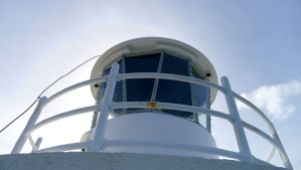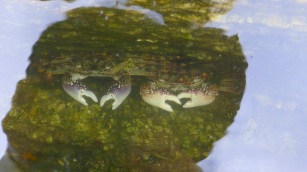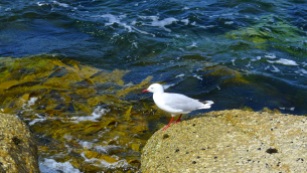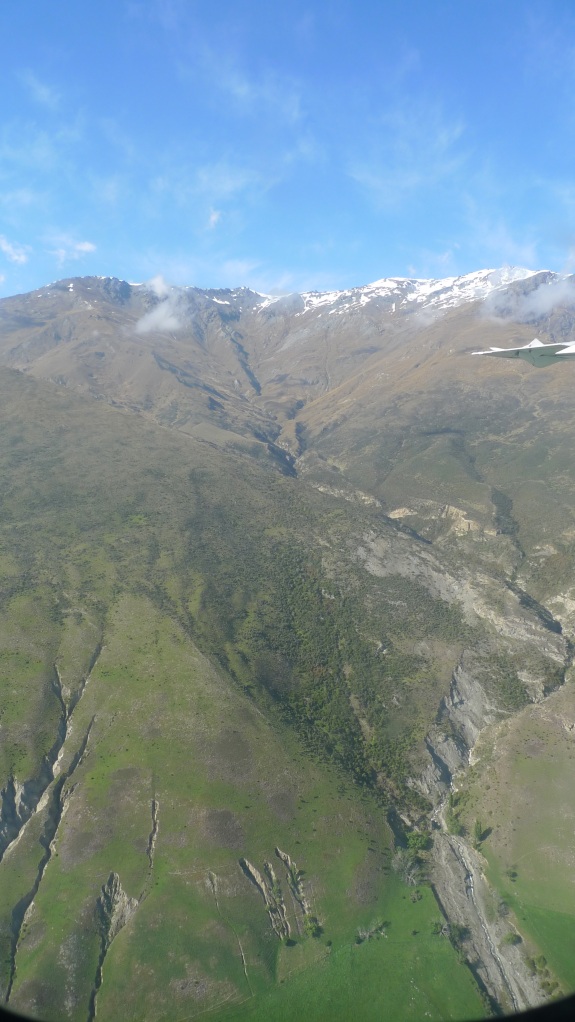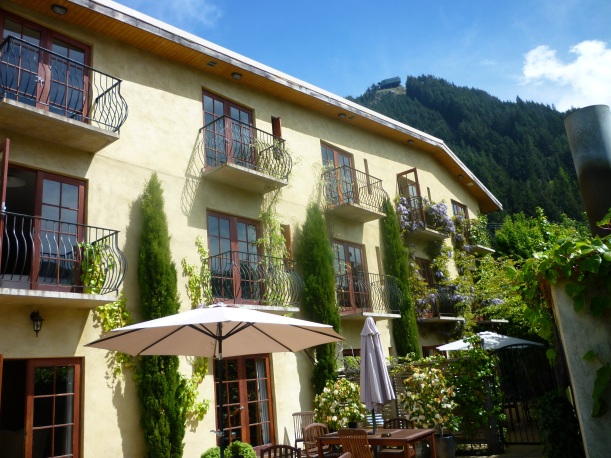Rest day at the Lightstation
Thanks to stretching adequately after the walk last night, climbing down from the top bunk wasn’t painful this morning, although an extra rung at the bottom of the ladder would have been helpful…
Sunrise was beautiful. I might have been the only one out taking full advantage of it – I’m not 100% sure as I didn’t turn around to check, but I didn’t hear anyone else up and about.
Yesterday we had arranged a lightstation tour for 10am today with Renata. Our tour started in the museum at the base of the lighthouse and heard how the lightstation used to also be a radar station during WWII. RAAF personnel were stationed on the point also; there are a number of photos from this time and physical remnants left on the point. The museum is open to the public.
After that we were allowed into the lighthouse! The lighthouse is still owned, operated and maintained by the Australian Maritime Safety Authority (AMSA) and public access is available only to groups under the supervision of a Park Ranger. At a height of only 19m (I think that’s to the beacon – the balcony is a couple of metres below) it’s not a big climb. Because the lighthouse sits atop granite cliffs the elevation above sea level is 117m, giving the beacon’s range 18 nautical miles (33km). Given the number of rocks and islands in this part of Bass Strait, the channel is reasonably narrow, and thus the lighthouse remains a very important visual navigation aid to sea-going vessels. There are also a couple of off-shore lights and lighthouses to help ships navigate Bass Strait.
Four lighthouse keepers and their families lived here, although the only original buildings left from that time are the cottage that we stayed in (Cottage #2) and the lighthouse itself. There was no road to the lightstation, so if anyone had to leave (e.g. for serious medical care) it was a long, hard journey back to civilisation – probably all the way back to Foster or Fish Creek. The township at Tidal River wasn’t constructed until 1946, and even the earlier camp at Darby River wasn’t established until the early 1900’s (when The Prom was given National Park status).
Read more about the details and history of the lighthouse here.
Renata also offered (and we accepted) a look in the other accommodation cottages available, as no one was in them at the time. Here’s a marked-up photo to help set the scene:
Note: the drinking tap I’ve highlighted on the centre path is provided primarily for day visitors. Overnight guests have the same fresh, filtered water from the convenience of taps in the cottages.
Parks Victoria Rangers Cottage (cottage #3) where you check in – if you’re not met at the top of the path like we were, after dragging yourself up the hill!
The newly renovated Couples Cottage (Cottage #4) is amazing! Such a view to the west! And there’s a window facing east in the bedroom. How can they make you leave after just two nights? The additional charge to stay here also includes a queen size bed and linen – that’ll make the pack a bit lighter! Definitely choosing this option next time.
Cottage no 5 at the end of the row is another multi-share cottage. Colin was busy painting inside when we visited, so we didn’t go through every room. Less spacious than the old lighthouse keepers cottage that we were staying in, but comfortable and probably the coziest in winter.
Finally, Cottage No 2 – the original Lighthouse Keepers Cottage – our home away from home for the two nights we were lucky to be there.
And separately, the kitchen! Let there be no more surprises here – there is a refrigerator, microwave, microwavable containers in the cupboards, gas oven and stovetop, plenty of pots, pans, dishes, plates, utensils, chopping boards, glasses, mugs – and a spare food draw!
Soon the first day visitors had arrived. Without packs, not wearing what I’d call hiking gear, and carrying only disposable (thin plastic) drink bottles. We were somewhat surprised by their attire. It’s as though they weren’t miles from anywhere, but at a local park.
Renata said they average 30-40 day visitors per day (a significant flaw in an otherwise perfect location – the presence of other people). Sure, the lighthouse may only be an interesting side trip for most people walking between Waterloo Bay and Roaring Meg camp sites, but surely that only explains the lack of backpacks?
If one of these young blokes (or girls, but the majority were young blokes) dropped their plastic water bottle and it broke, he’d better hope he could reply on a friend to share water with him until the next stop. They mightn’t be walking 25km in one go like we were, but if it was a hot day like yesterday, being one bottle down (assuming they had more than one) was a serious blow all the same. The owners of Black Cockatoo Cottages told us they hadn’t had rain this year, and the park at the end of summer was definitely looking dry. We were carrying water purification tablets, but I doubt these kids were, or had anything similar, and it’s not safe to drink the water straight from the creeks.
Don’t get me started on their shoes!
When the lightstation was first built back in the 1850’s, equipment and supplies were brought in by boat every six months. A flying fox was set up from a site just below the hill known as the ‘eastern landing’ to the top of the point, because even just lugging yourself up the hill in those days must have been much more of a challenge – there wasn’t a nice concrete path back then! There was a western landing used at one time too, but the eastern side proved better (probably more sheltered from the prevailing winds). Offloading cargo from either side was tricky business at the best of times.
After lunch we decided to brave the steep path once again to see the eastern landing.
Walking down the hill is easier than walking up was yesterday (hmmm, no surprise there), but I was very glad that we weren’t wearing back packs today.
There’s no beach or convenient looking place for a swim – something that used to torment the early lighthouse keepers during hot summer days. I think Renata said seals are sometimes seen on the rocks. The deep, clear water and healthy kelp attached to the rocks looks like great seal habitat.
The oranged rocks are so reminiscent of the north and eastern coast of Tasmania – which is not very far away, so it’s hardly a surprise.
We discovered that walking up the hill isn’t half as bad when you’re refreshed and not carrying a heavy pack. Still very steep though.
The rest of the afternoon was passed lounging around drinking wine (trying to finish it so we didn’t have to carry it out), eating cheese (trying to finish it so we didn’t have to carry it out), then taking a stroll around the place to walk off the wine and cheese before dinner.
I saw a juvenile White-bellied Sea-eagle too, but without significantly more zoom than what currently I’ve got I can’t show you a decent photo, so you’re just going to have to take my word for it. I was pretty chuffed when I realised what I had seen.
Other hikers planning to stay had arrived and that night not only was our cottage full (sleeping 10 in 4 rooms) but people had arrived to stay at the couple’s cottage next to the rangers cottage. I bet they wished they had come for more than one night! (Neal and Elle reported that you can’t book accommodation at the lightstation for a Thursday night).
Sunset was in a gorgeous purple theme…
Unlike the previous night when it (actually!) rained, tonight was clear and had the bonus of a more-than-half-full waxing moon. After dinner we grabbed torches and cameras and went out.
The wombat and baby had already been spotted earlier (in the back garden) but heading to the top of the path we again disturbed the pair of swamp wallabies as we took photos of the moonlight on the eastern bay.
Stephen noticed he didn’t really need his torch to find wombats – he could hear them chewing as he was positioning his camera to photograph something else! They’re noisy enough when they’re only about a metre away. I guess you should carry a torch to make sure you don’t trip over one?!
I was watching two in the garden outside the rangers cottage when something startled one. There was a rustle, then in a split second they were both gone! It’s amazing how fast they can move! They must have both been not much further than a metre or two from a burrow entrance.
Previously:
Preparing for Wilsons Promontory Lightstation hike (hiking food, tips on what you will/won’t need to pack)
Wilsons Promontory Lighthouse Part 1 (walking to the lightstation from Tidal River via Oberon Bay Walking Track and Telegraph Track
Next
Wilsons Promontory Lighthouse Part 3 (Return to Tidal River via South East Walking Track / Waterloo Bay)
: )











